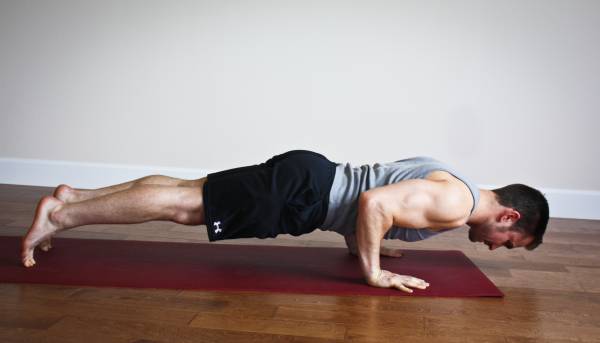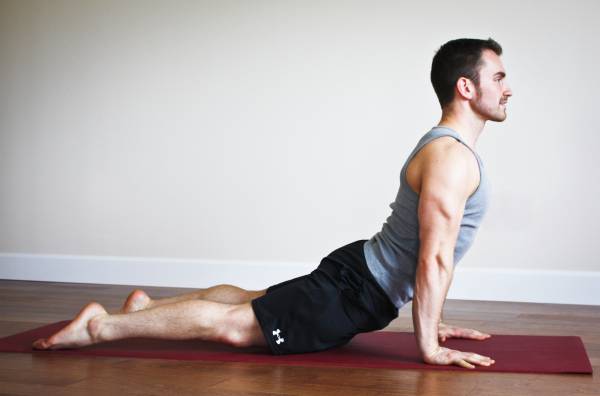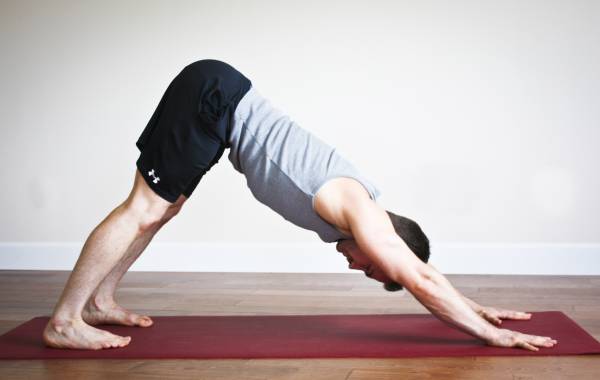Vinyasa yoga and power yoga are arguably the most popular types of yoga in the United States. However, many teachers do not take the time to teach how to do a proper vinyasa. Vinyasa is a term to describe a flow of dynamic movement. When a teacher says “take a vinyasa,” they are specifically referring the sequence of plank to chaturanga to upward facing dog to downward facing dog. If the vinyasa is not performed properly, over time the student is at risk of injury to the rotator cuff or lower back.
This is unfortunate considering the fact that many students turn to yoga as a safe way to exercise. It is the teacher’s responsibility to do everything possible to keep the students safe in a class. Whether the classes are so big the teacher cannot see the student’s form, the vinyasa is occurring too fast, or the teacher is just plain lazy, something has to change to keep students safe and injury free.
Here is how to do a correct and safe vinyasa:
A proper vinyasa should be done at a slow pace. This pace should be such that each pose is felt rather than just passed through without integrity.
A balance of energy between the front and back of the body should be felt in plank pose. Often there is too much energy reaching forward, which puts pressure on the shoulders. There needs to be an isometric lifting of the legs. The head is looking a foot or two forward so the head is level and not hanging down. The hands are pressing firmly and evenly with the fingers wide apart.
 On an exhale, the weight shifts forward to lower to chaturanga. This is where awareness of the shoulders is important. As the students lowers there is an opposing resistance of lifting through the head of the shoulders. In chaturanga the shoulders are no lower than the elbows. In the full pose the elbows are at a 90-degree angle and squeezing in towards the ribs. The body is in one straight line with energy in the legs. The sternum is reaching forward and the tailbone is reaching back.
On an exhale, the weight shifts forward to lower to chaturanga. This is where awareness of the shoulders is important. As the students lowers there is an opposing resistance of lifting through the head of the shoulders. In chaturanga the shoulders are no lower than the elbows. In the full pose the elbows are at a 90-degree angle and squeezing in towards the ribs. The body is in one straight line with energy in the legs. The sternum is reaching forward and the tailbone is reaching back.
A common mistake in chaturanga is to dip the shoulders lower than the elbows. If this becomes habitual the shoulders are at risk of rotator cuff injury. It is okay to keep the shoulders higher than the elbows or to lower to the knees until the strength is built up to keep the proper form.
 On an inhale, the heads of the shoulders roll up and back, the arms straighten, and the feet are flipped to plantar flexion for upward facing dog. The head is gazing forward or slightly up. It is important to engage the rhomboid muscles (between the shoulder blades) to open the chest and protect the rotator cuff. The sternum is lifting while the tailbone is lengthening down and back toward the heels. There is a lifting of the side body from the waist to the underarms. The thighs are engaged and lifted off of the ground. The lifting of the thighs is important for keeping the lower back safe. The toes are pressing back and the tops of the feet are grounded. All ten toenails are pressing firmly into the ground to keep the ankles stable.
On an inhale, the heads of the shoulders roll up and back, the arms straighten, and the feet are flipped to plantar flexion for upward facing dog. The head is gazing forward or slightly up. It is important to engage the rhomboid muscles (between the shoulder blades) to open the chest and protect the rotator cuff. The sternum is lifting while the tailbone is lengthening down and back toward the heels. There is a lifting of the side body from the waist to the underarms. The thighs are engaged and lifted off of the ground. The lifting of the thighs is important for keeping the lower back safe. The toes are pressing back and the tops of the feet are grounded. All ten toenails are pressing firmly into the ground to keep the ankles stable.
 The exhale then brings the student back to downward facing dog. Downward facing dog is the resting pose of vinyasa. The weight is back toward the heels. The tops of the thighs are pressing back. If the upper back is rounding then the knees can bend to press the chest towards the thighs. It is important to lift the shoulders rather than collapsing or dipping them. The hands are pressing firmly. The forearms hug inward while the inner shoulders widen.
The exhale then brings the student back to downward facing dog. Downward facing dog is the resting pose of vinyasa. The weight is back toward the heels. The tops of the thighs are pressing back. If the upper back is rounding then the knees can bend to press the chest towards the thighs. It is important to lift the shoulders rather than collapsing or dipping them. The hands are pressing firmly. The forearms hug inward while the inner shoulders widen.
I truly believe yoga can transform the body and mind with proper form. When the poses are performed correctly, the energy can flow fluidly through the body. Vinyasa is a powerful sequence of poses. Practice vinyasa safely and enjoy your yoga class!
Photos courtesy of Brandon Hofer and property of Breaking Muscle.






